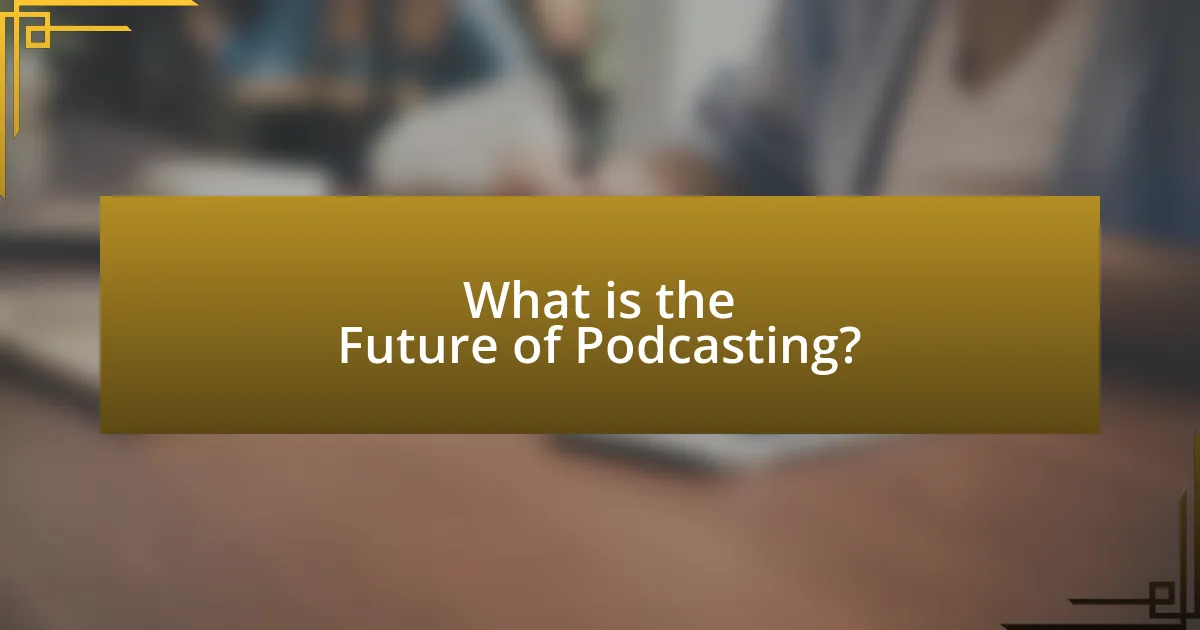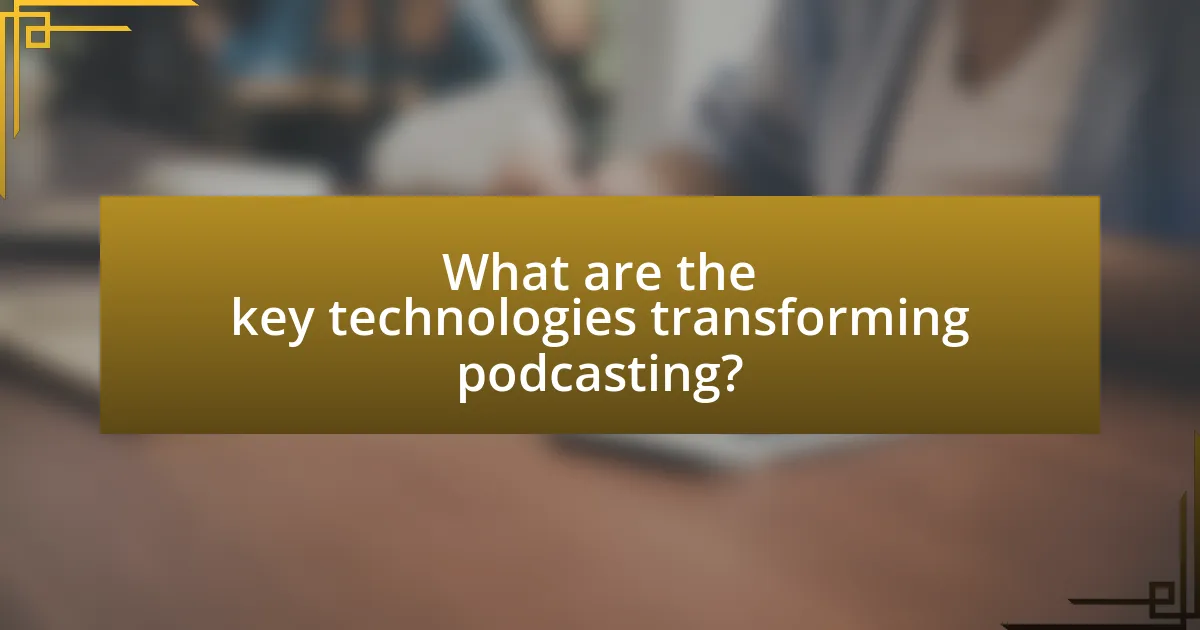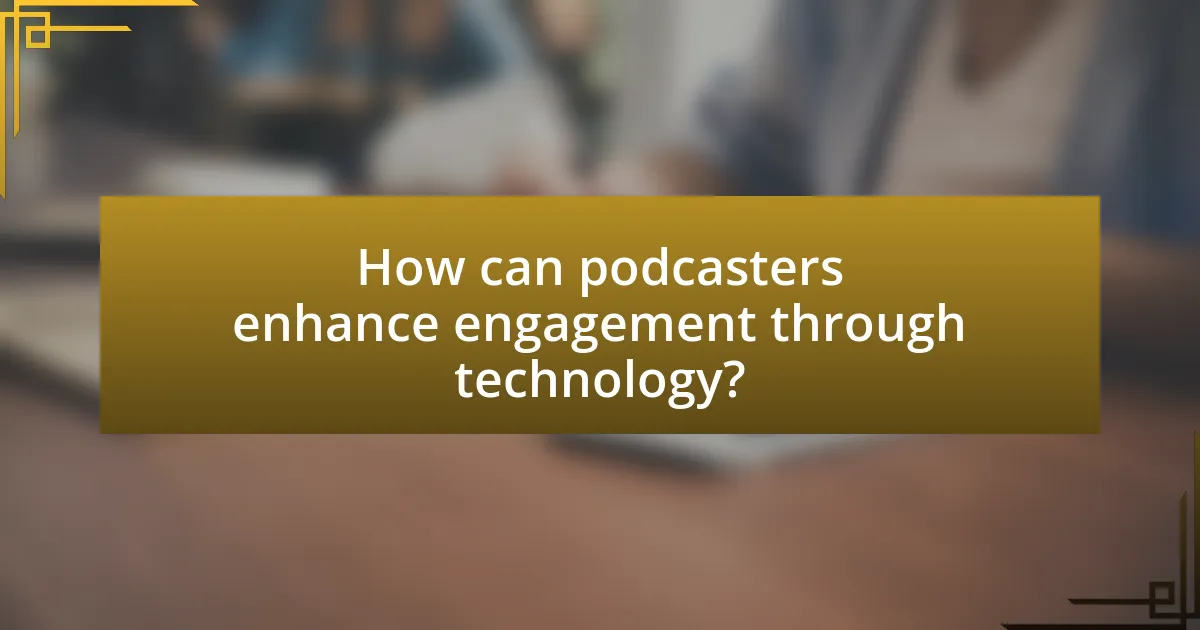The article focuses on the future of podcasting, emphasizing the integration of technology to enhance listener engagement. It outlines how advancements such as artificial intelligence, machine learning, and interactive features are transforming content creation, distribution, and audience interaction. Key metrics for measuring engagement, including listener retention and completion rates, are discussed, along with the importance of fostering community through interactive elements. The article also highlights emerging trends and technologies that will shape the podcasting landscape, indicating a shift towards more personalized and immersive listening experiences.

What is the Future of Podcasting?
The future of podcasting is characterized by increased integration of technology to enhance listener engagement. As platforms evolve, features such as interactive elements, personalized content recommendations, and advanced analytics will become standard, allowing creators to tailor experiences to individual preferences. According to a report by Edison Research, the number of monthly podcast listeners in the U.S. has grown to over 100 million, indicating a significant market potential that will drive innovation. Additionally, advancements in artificial intelligence and machine learning will enable more sophisticated content curation and audience targeting, further solidifying podcasting’s role in digital media.
How is technology shaping the future of podcasting?
Technology is shaping the future of podcasting by enhancing content creation, distribution, and audience engagement. Innovations such as artificial intelligence and machine learning are enabling podcasters to analyze listener preferences and optimize content accordingly. For instance, AI-driven tools can transcribe episodes, generate show notes, and even suggest topics based on trending themes, thereby streamlining the production process. Additionally, advancements in audio quality and streaming technology are improving the listening experience, making podcasts more accessible across various devices. According to a report by Edison Research, over 80% of the U.S. population is familiar with podcasting, indicating a growing audience that technology continues to engage effectively.
What technological advancements are currently influencing podcasting?
Technological advancements currently influencing podcasting include artificial intelligence, enhanced audio editing software, and improved distribution platforms. Artificial intelligence is being utilized for content creation, transcription, and personalized recommendations, which enhances listener engagement. Enhanced audio editing software allows creators to produce higher-quality sound with features like noise reduction and automated mixing, making it easier to create professional-grade podcasts. Improved distribution platforms, such as Spotify and Apple Podcasts, offer advanced analytics and monetization options, enabling podcasters to reach wider audiences and optimize their content based on listener data. These advancements collectively contribute to a more engaging and accessible podcasting experience.
How do these advancements enhance listener engagement?
Advancements in technology enhance listener engagement by providing personalized content, interactive features, and improved accessibility. Personalized algorithms analyze listener preferences, enabling tailored recommendations that keep audiences more invested. Interactive features, such as live Q&A sessions and audience polls, foster real-time participation, making listeners feel like active contributors rather than passive consumers. Additionally, improved accessibility through various platforms and devices ensures that content is available anytime and anywhere, increasing the likelihood of listener retention and engagement. These elements collectively create a more immersive and participatory experience, leading to higher listener satisfaction and loyalty.
Why is engagement important in podcasting?
Engagement is crucial in podcasting because it directly influences listener retention and growth. High engagement levels lead to increased listener loyalty, which is essential for building a dedicated audience. According to a 2021 report by Edison Research, 80% of podcast listeners are more likely to remember ads when they are engaged with the content, demonstrating that engagement not only enhances the listening experience but also drives monetization opportunities. Furthermore, engaged listeners are more likely to share episodes, expanding the podcast’s reach and attracting new audiences.
What metrics define engagement in podcasting?
Key metrics that define engagement in podcasting include listener retention rate, average listen duration, and episode completion rate. Listener retention rate measures the percentage of listeners who continue to listen to a podcast over time, indicating how well content keeps the audience’s interest. Average listen duration tracks how long listeners stay engaged with an episode, providing insight into content effectiveness. Episode completion rate reflects the proportion of listeners who finish an episode, serving as a strong indicator of overall engagement. According to a report by Edison Research, podcasts with higher retention and completion rates tend to have more loyal audiences, reinforcing the importance of these metrics in assessing engagement.
How does listener engagement impact podcast success?
Listener engagement significantly impacts podcast success by directly influencing audience retention, growth, and monetization opportunities. High levels of engagement, such as listener feedback, social media interaction, and participation in discussions, lead to a loyal audience base that is more likely to share content and recommend the podcast to others. According to a study by Edison Research, engaged listeners are 60% more likely to recommend a podcast to friends, which can drive organic growth. Furthermore, podcasts with higher engagement metrics often attract better sponsorship deals, as advertisers seek platforms with active and involved audiences. Thus, fostering listener engagement is crucial for achieving long-term success in the podcasting landscape.

What are the key technologies transforming podcasting?
Key technologies transforming podcasting include artificial intelligence, advanced audio editing software, and interactive platforms. Artificial intelligence enhances content discovery through personalized recommendations and automated transcription services, making podcasts more accessible. Advanced audio editing software, such as Adobe Audition and Descript, streamlines the production process, allowing creators to produce high-quality audio with ease. Interactive platforms, like Spotify and Apple Podcasts, are integrating features such as listener polls and Q&A sessions, fostering greater audience engagement. These technologies collectively improve the podcasting experience for both creators and listeners, driving the medium’s growth and evolution.
How do AI and machine learning contribute to podcasting?
AI and machine learning enhance podcasting by automating content creation, improving audio quality, and personalizing listener experiences. These technologies enable podcasters to generate transcripts and summaries quickly, making content more accessible. For instance, AI-driven tools like Descript utilize machine learning algorithms to edit audio and video efficiently, allowing creators to focus on content rather than technical aspects. Additionally, machine learning algorithms analyze listener behavior to recommend episodes tailored to individual preferences, increasing engagement. According to a report by Edison Research, personalized recommendations can significantly boost listener retention rates, demonstrating the effectiveness of AI in enhancing the podcasting experience.
What are the applications of AI in content creation?
AI applications in content creation include automated writing, content curation, and personalized recommendations. Automated writing tools, such as GPT-3, generate articles, scripts, and social media posts, significantly reducing the time required for content production. Content curation platforms utilize AI algorithms to analyze user preferences and suggest relevant articles or topics, enhancing audience engagement. Additionally, AI-driven analytics provide insights into audience behavior, allowing creators to tailor content to specific demographics, thereby increasing relevance and impact. These applications demonstrate AI’s role in streamlining the content creation process and improving audience interaction.
How does machine learning personalize listener experiences?
Machine learning personalizes listener experiences by analyzing user data to tailor content recommendations and interactions. By leveraging algorithms that process listening habits, preferences, and feedback, machine learning systems can identify patterns that inform personalized suggestions. For instance, platforms like Spotify utilize collaborative filtering and natural language processing to recommend podcasts based on individual listening history and similar user profiles, enhancing user engagement and satisfaction. This data-driven approach has been shown to increase listener retention rates, as personalized content aligns more closely with user interests, leading to a more engaging and relevant listening experience.
What role does interactive technology play in podcasting?
Interactive technology enhances podcasting by enabling real-time audience engagement and feedback. This technology allows listeners to interact with content through features like polls, Q&A sessions, and live chats, fostering a more immersive experience. For instance, platforms such as Spotify and Apple Podcasts have integrated features that allow listeners to respond to episodes or participate in discussions, which can lead to increased listener retention and community building. Research indicates that podcasts incorporating interactive elements see a 30% increase in listener engagement compared to traditional formats, demonstrating the significant impact of interactive technology on audience involvement and satisfaction.
How can podcasts utilize augmented reality (AR) and virtual reality (VR)?
Podcasts can utilize augmented reality (AR) and virtual reality (VR) by creating immersive experiences that enhance listener engagement. For instance, AR can overlay digital content onto the real world, allowing listeners to interact with visual elements related to the podcast’s theme, such as 3D models or animations that complement the audio narrative. VR can transport listeners into a fully immersive environment where they can experience the podcast’s content in a more engaging way, such as attending a virtual event or exploring a virtual world that aligns with the podcast’s subject matter. Research indicates that immersive technologies like AR and VR can significantly increase user engagement and retention rates, making them valuable tools for podcasters aiming to innovate and captivate their audience.
What are the benefits of incorporating interactive elements in podcasts?
Incorporating interactive elements in podcasts enhances listener engagement and retention. Interactive features, such as polls, quizzes, and listener feedback opportunities, create a two-way communication channel between hosts and audiences, fostering a sense of community. Research indicates that podcasts with interactive components can increase listener satisfaction by up to 30%, as they allow audiences to actively participate in the content rather than passively consume it. This engagement leads to higher completion rates and encourages listeners to share episodes, ultimately expanding the podcast’s reach and influence.

How can podcasters enhance engagement through technology?
Podcasters can enhance engagement through technology by utilizing interactive features such as live streaming, audience polls, and social media integration. These technologies allow listeners to participate in real-time discussions, provide feedback, and share their thoughts, which fosters a sense of community and connection. For instance, platforms like Clubhouse and Twitter Spaces enable podcasters to host live audio sessions where listeners can join the conversation, significantly increasing listener involvement. Additionally, incorporating tools like listener surveys and analytics can help podcasters tailor content to audience preferences, further boosting engagement. According to a study by Edison Research, 70% of podcast listeners prefer shows that allow for audience interaction, highlighting the effectiveness of these technological enhancements in driving listener engagement.
What strategies can podcasters implement to leverage technology?
Podcasters can leverage technology by utilizing advanced audio editing software, implementing dynamic ad insertion, and engaging with listeners through interactive platforms. Advanced audio editing software, such as Adobe Audition or Audacity, allows podcasters to enhance sound quality and create professional-grade content, which can lead to increased listener retention. Dynamic ad insertion technology enables podcasters to serve targeted advertisements based on listener demographics, maximizing monetization opportunities. Additionally, interactive platforms like social media and podcasting apps with listener feedback features foster community engagement, allowing podcasters to adapt content based on audience preferences and enhance overall listener experience.
How can social media integration improve podcast visibility?
Social media integration can significantly improve podcast visibility by leveraging platforms with large user bases to promote content. When podcasts share episodes, clips, and engaging visuals on social media, they tap into existing networks, increasing reach and attracting new listeners. According to a study by Edison Research, 54% of podcast listeners discover new shows through social media, highlighting its effectiveness as a promotional tool. Additionally, social media allows for real-time interaction with audiences, fostering community engagement and encouraging shares, which further amplifies visibility.
What tools can podcasters use for audience interaction?
Podcasters can use tools such as social media platforms, live streaming services, and audience engagement apps for audience interaction. Social media platforms like Twitter and Instagram allow podcasters to engage with listeners through comments, polls, and direct messages, fostering a community around their content. Live streaming services, such as YouTube Live or Twitch, enable real-time interaction during episodes, allowing listeners to ask questions and provide feedback instantly. Additionally, audience engagement apps like Podchaser and SpeakPipe facilitate listener feedback and voice messages, enhancing the connection between podcasters and their audience. These tools are essential for building a loyal listener base and improving content based on audience input.
What are the best practices for using technology in podcasting?
The best practices for using technology in podcasting include investing in high-quality recording equipment, utilizing reliable editing software, and leveraging distribution platforms effectively. High-quality microphones and headphones enhance audio clarity, which is crucial for listener engagement. Editing software like Audacity or Adobe Audition allows for professional sound editing, ensuring a polished final product. Additionally, using platforms such as Libsyn or Anchor for distribution maximizes reach and accessibility, as they provide analytics to track listener engagement and demographics. These practices are supported by industry standards that emphasize audio quality and accessibility as key factors in successful podcasting.
How can podcasters measure the effectiveness of their technological tools?
Podcasters can measure the effectiveness of their technological tools by analyzing key performance indicators (KPIs) such as listener engagement, download statistics, and audience feedback. These metrics provide concrete data on how well the tools facilitate content delivery and audience interaction. For instance, tracking download numbers can indicate the reach of a podcast episode, while listener retention rates can reveal how engaging the content is, thus reflecting the effectiveness of the editing and production tools used. Additionally, surveys and social media interactions can provide qualitative insights into audience satisfaction and preferences, further validating the impact of the technological tools employed.
What common pitfalls should podcasters avoid when integrating technology?
Podcasters should avoid overcomplicating their technology setup, as this can lead to technical difficulties and hinder the recording process. Simplifying the technology stack ensures smoother operations and reduces the likelihood of errors during production. Additionally, podcasters must be cautious about neglecting audience accessibility; failing to provide transcripts or alternative formats can alienate potential listeners. Research indicates that 15% of the population has hearing impairments, highlighting the importance of inclusivity in podcasting. Lastly, ignoring analytics can prevent podcasters from understanding their audience’s preferences, which is crucial for content improvement and engagement. By focusing on these areas, podcasters can enhance their integration of technology effectively.
What future trends should podcasters watch for?
Podcasters should watch for the increasing integration of artificial intelligence and machine learning in content creation and audience engagement. These technologies are enabling personalized recommendations and automated editing, enhancing the listener experience. According to a report by PwC, the podcasting industry is projected to grow to $1 billion by 2024, driven in part by advancements in technology that improve accessibility and interactivity. Additionally, the rise of interactive podcasts, which allow listeners to engage with content in real-time, is expected to reshape how audiences consume audio content, making it more immersive and participatory.
How might emerging technologies further change podcasting?
Emerging technologies will further change podcasting by enhancing interactivity and personalization through AI-driven content recommendations and immersive audio experiences. For instance, AI algorithms can analyze listener preferences to curate tailored podcast playlists, increasing user engagement and satisfaction. Additionally, advancements in augmented reality (AR) and virtual reality (VR) can create immersive storytelling environments, allowing listeners to experience narratives in a more engaging manner. According to a report by PwC, the global podcasting market is expected to grow significantly, driven by these technological innovations, indicating a shift towards more interactive and personalized content consumption.
What predictions can be made about the evolution of podcasting engagement?
Predictions about the evolution of podcasting engagement indicate a significant increase in interactivity and personalization. As technology advances, platforms are likely to integrate features such as real-time audience feedback, allowing listeners to engage directly with hosts during episodes. According to a report by Edison Research, the number of monthly podcast listeners in the U.S. has grown from 21% in 2019 to 41% in 2023, highlighting a trend towards greater audience involvement. Additionally, advancements in AI and machine learning will enable more tailored content recommendations, enhancing user experience and retention. This evolution suggests that podcasting will increasingly become a two-way communication medium, fostering deeper connections between creators and audiences.

Leave a Reply